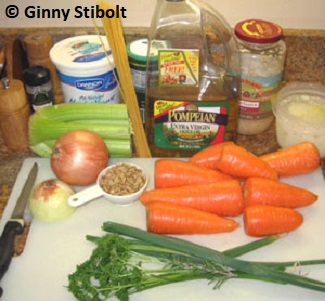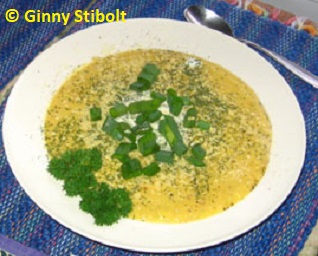|

Freshly pulled carrots from the garden.
|
Sweet treat carrots
by Ginny Stibolt
As a transplanted gardener, one of the pleasures of being here
in northern Florida is that we can have vegetables from the garden
year round. In early October I planted mixed greens, Swiss
chard, chives, parsley, onions, and carrots. About two weeks ago,
I started harvesting the carrots, but soon it became clear that
I really needed to pull them all: they were ready.
But before I tell you more about our carrots and how we used them,
a bit of history and trivia.
The traveling carrots
Carrots (Daucus carota) are in the same family as parsley,
dill, fennel, and other herbs from the Mediterranean region, Apiaceae.
Most are biennials and develop a taproot to store energy for flowering
the second year. The tiny flowers are arranged in a flat
or slightly rounded head. In the very center of the carrot flower
head there is one dark purple flower while the rest of the flowers
are an off white. The other herbs have been cultivated for their
leaves, while carrot breeding has centered on its root characteristics.
Its ancestor is native to Afghanistan region and probably had
a bitter, woody, and purple root. The carrot has been under
cultivation for 5,000 years. Through selection for taste and medicinal
qualities and with some breeding with a white-rooted variant from
North Africa, breeders in the Netherlands eventually produced
our modern sweet orange carrot in the 1700s. It was highly prized
during the reign of William of Orange.
The carrot arrived in the New World before the Mayflower. It
soon escaped cultivation and you probably know these escaped carrots
as Queen Anne's lace. In many parts of the country it is
an invasive weed I haven't seen Queen Anne's lace in Florida,
but it does occur in some of the panhandle counties. There is
an American relative, wild American carrot (D. pusillus),
that is somewhat more widespread across northern Florida.
It is differentiated from Queen Anne's lace by a fringe of leaves
around the flower heads. This would be a great addition to your
butterfly garden because it's a larval food source for the black
swallowtail butterfly.
Politics and horticulture are sometimes at odds. While horticulturally we would consider the carrot to be a vegetable, the European Union declared carrots to be fruits in its jam directive in 1979 when it set standards for how much "fruit" was to be in jams.
Also, in 1893, the U.S. Supreme Court, to settle a dispute over import taxes, classified tomatoes as vegetables despite the fact that their seed content clearly defines them as a fruit.
Cultivating carrots
I bought my carrot seeds from Burpee. The cultivar is "Sweet
Treat". Here is their description:
"70 days. 5" long. Very sweet
and crunchy. This sugary Japanese kuroda type has tapered
spike-shaped roots. One of the tastiest carrots we've ever
offered."
You can see how I was lured to this variety. I planted the first
two short rows in early October, then planted the second crop
in December, and I've just planted the third crop. We'll probably
be planting the tomatoes in between this last set of carrots.
Our vegetable bed has loose, friable soil where we've dug in a fair amount of
horse manure over the last three years. Carrots really need the soft
substrate with no rocks so the roots will be nice and straight.
These carrots are indeed very sweet and when they are fresh from the
garden, they do not need to be peeled. Because the first crop was
ready to be pulled, we had a lot of them to use.
<< I decided to make some
carrot soup and gathered the ingredients. I'm not sure where this
recipe first came from, but I've been using it for the last twenty years or
so. I no longer have the original recipe, so every time I make it, it's is a
variation. I looked online and didn't find any other recipes that used
pasta for body.
In a soup pot, brown in olive oil 1&1/2 medium onions, 2/3 c of
chopped celery, 1/4 c sunflower seeds, 1/4 c barley, 1 tsp fresh rosemary,
and a generous tblsp of garlic. As these ingredients brown, chop 8 fat carrots and add to the browning veggies. Stir frequently.
As the onions become translucent, add 2 c of chicken stock* and 6 c of
water. Bring to a boil and then simmer for about 25 minutes until
carrots become soft. Add spaghetti--an inch in diameter if you hold it
in a bunch. Also add 2 or 3 springs of parsley and several wild garlic
leaves. Simmer 10 more
minutes until everything is soft. Remove from burner and let it cool
for 20 minutes or more. Run the ingredients through a blender until mostly
smooth. Stir in 1&1/2 c of nonfat plain yogurt and 1/4 c grated
parmesan cheese. Garnish with
a dollop of yogurt, chopped onion greens, freshly ground pepper, and dried
dill weed.
This is a hearty soup is good hot or cold. I was
surprised to see how yellow it was using our freshly pulled Sweet Treat
carrots. Delicious! >>
It's not too late--plant some carrots and enjoy a
crunchy winter sweet treat.
*(Note: I still make this soup, but no longer use
chicken stock. It's still a wonderful soup and I included this
recipe in "Organic Methods for Vegetable Gardening in Florida.
I called it "Ugly carrot soup.")
Resources:
For a detailed look at the history of carrots: www.carrotmuseum.com.
|




